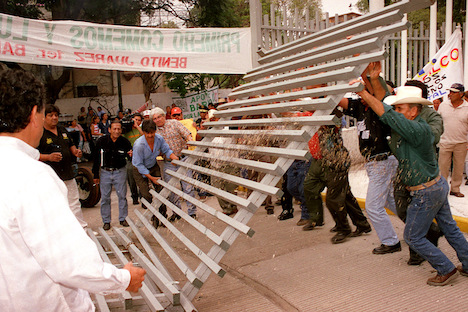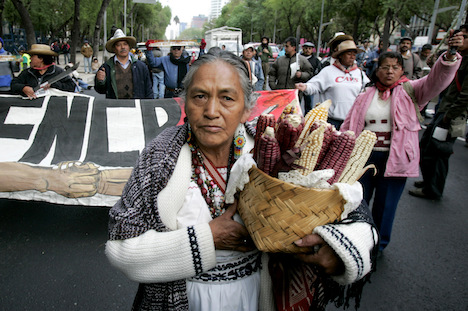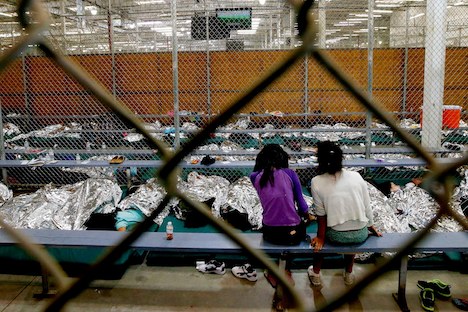Mexico’s Case Against NAFTA: An Economic and Environmental Wrecking Ball
 Print This Print This
By James Carey | MintPress
MintPress
Friday, Jul 27, 2018
If Trump were to be believed, Mexico somehow “won” with NAFTA. Yet, for some inexplicable reason, the country is still plagued by crime and full of people who risk leaving it for greener pastures.
 |
| Mexican activists carry signs that read in Spanish “Racism is not commerce,” at a protest against the seventh round of the North American Free Trade Agreement, NAFTA, renegotiations, in front of the foreign relations office in Mexico City, Feb. 27, 2018. Marco Ugarte | AP |
There has been a lot of talk by President Donald Trump over the past two years about the North American Free Trade Agreement (NAFTA) and how it has hurt U.S. workers, but it is only reasonable to ask: What has it done to Mexico?
During the 2016 U.S. Presidential election, a single issue united supporters of both Senator Bernie Sanders and Donald Trump: the utter failure of neoliberal trade agreements like NAFTA and the then-pending Trans-Pacific Partnership (TPP). Both of the candidates’ campaigns rightly connected the agreements to the deindustrialization of the U.S. through the migration of jobs south of the border, where labor costs are cheaper, and to the flooding of markets with cheap tariff-free goods.
Following his election victory, President Trump soon set about renegotiating the Clinton-era NAFTA agreement and quickly found an unexpected partner eager for talks to commence: Mexico.
Much like the U.S., Mexico has expressed an urge to begin renegotiating NAFTA “as soon as possible” according to Mexico’s then-Foreign Relations Minister, Luis Videgaray. While Videgaray was ushered out with the old administration, the new government under President Andrés Manuel López Obrador has expressed hope that NAFTA negotiations will be completed within the next few months.
So is Mexico so eager to open talks with the U.S. on NAFTA if it was “the worst deal ever approved” by Washington? A deal that was helping Mexico get one over on their neighbors to the north. The answer likely has something to do with the devastation that neoliberal “free trade” brings with it wherever it goes.
Like most countries before they embraced neoliberalism, Mexico before NAFTA was once home to a diverse and robust domestic agricultural sector, less reliant on imported food and manufacturing jobs, and on track to have a fairly Western standard of living. Since the massive trade treaty took effect in 1994, however, this all changed. Instead, NAFTA set off a series of devastating policies that are still ravaging Mexico today.
Mexican workers: the other victims of NAFTA
If one only listened to Donald Trump they may believe that all the high-paying jobs “missing” from the U.S. have gone to Mexico. While this isn’t correct, it is true that many companies have, and still are, moving production to Mexico. But there are some major misconceptions about what that influx of jobs has actually done for the average Mexican worker.
When NAFTA was first sold to the public of Mexico, many lofty promises were made about a brighter future for the country with “better” jobs and higher wages. Upon the treaty’s implementation, that myth was kept alive with regular “evaluations” from U.S. government-linked think-tanks like The Heritage Foundation, which gave NAFTA an “A” grade three years into the agreement and calling it “a remarkable success.”
But if you asked the Mexican worker to grade NAFTA, you’d probably get a very different answer. The unemployment rate in Mexico still remains about where it was in 1996, and economic factors point to a major decline for Mexico after about one year from the signing of NAFTA in 1994.
 |
| Farmers break the gate of the Economy Ministry during a protest against NAFTA, Oct. 29, 2002, in Mexico City. Ismael Rojas | AP |
The first major factor demonstrating the negative effects of NAFTA on Mexico are the hard numbers, such as the average real wages of Mexican workers. While higher wages were promised, they seem to have come to fruition only among higher skilled workers — primarily in the U.S. border region in the north of Mexico, where many U.S. firms outsource “professional” jobs making products on the cheap to export back north.
As for low-skill and low-paying jobs, wages adjusted for inflation in industries such as light manufacturing have actually fallen since NAFTA went into effect, a fact addressed in recent NAFTA negotiations with the U.S. who is seeking to enforce a minimum wage and higher labor standards. Mexico has thus far been unwilling to let Washington set its internal policies and there is debate as well on whether these proposed rules would be able to roll back the worst effects of the treaty.
On top of this, as the years went on and trade opened further, many of Mexico’s low-skilled jobs were lost to southeast Asian countries, where wages were even lower than those in Mexico. The loss of jobs and domestic consumer product manufacturing also meant that goods produced in Mexico were more expensive than those from Asia, leading to a decline in Mexican-owned businesses that produced products for the Mexican market, and to an almost six-fold increase in imports since 1995.
This not only hurt domestic manufacturing but also had a devastating effect on Mexican agriculture, which, like consumer-product manufacturing, used to be populated by Mexican-owned farms growing food for Mexican consumers. This changed following NAFTA, as tariffs for government-subsidized crops, like corn from the U.S., were dropped and U.S. goods flooded the Mexican market. Mexico did introduce subsidies in a bid to remain competitive, but the lion’s share of these ended up going to larger farming firms that typically worked with multinational corporations.
The new competition drove Mexico’s family farms in into the ground and displaced many of their workers. When the farmers lost their land, things continued to get worse, as NAFTA allowed for easy transfers of property by the state to multinational corporations. That meant that most of this farmland lost in Mexico was later sold to companies like Tyson, Nestle and Monsanto for pennies on the dollar.
 |
| Farmers protest the end of import protections under NAFTA for corn and bean crops in Mexico City, Jan. 2, 2008. Eduardo Verdugo | AP |
The problem with the sudden migration of U.S. capital into Mexico was that its benefits not only never reached the Mexican people but also failed to lift Mexico’s economy, as had been predicted. Instead, within the first 20 years under NAFTA, Mexican GDP growth rate declined from around five percent in the mid-90s to below one percent now. In comparison, the current average GDP growth among Latin American countries as a whole is about 1.9 percent.
The only real economic indicator that did flash positive signs for the Mexican economy was the volume of trade with fellow North American states, a factor that had very little real positive effects for the average Mexican.
NAFTA’s other negative effects on Mexico — many relating to giant multinational firms moving their operations to Mexico — cannot be measured by economic indicators alone. While some of the damage done by companies like Monsanto and Coca-Cola in Mexico can be measured in numbers, the destruction they’ve wreaked on the environment is nearly impossible to quantify.
The destruction of Mexico’s environment
When NAFTA was first signed it included several clauses concerning environmental protection. Unfortunately for Mexico, those parts of the treaty were non-binding, leaving certain industries, such as mining, prone to abuse by multinational corporations.
Mexico’s mining industry exemplifies the type of business practices that NAFTA, combined with a series of “pro-business” Mexican administrations — which passed laws encouraging U.S. and Canadian mining firms to move south — brought about. The industry accounts for about 20 percent of Mexico’s total land use and provides perspective on the power that industry holds over the country.
Mining companies are very comfortable not only using but abusing, their influence on government policy — as evidenced by the lucrative contracts these companies received which many suspect are the result of corruption, especially bribery, which since NAFTA was enacted, has essentially become factored into the cost of doing business. This corruption has become a major source of economic woes for Mexico. Some of the worst abuses were catalogued in a 2014 report by Greenpeace, which stated that “NAFTA has encouraged a boom in environmentally destructive mining activities” through its protections for corporations, and through the previously mentioned “voluntary” environmental clauses in the treaty, as well as through the mandated use of notoriously crooked trade dispute bodies like the World Trade Organization’s (WTO) Dispute Settlement System, which almost always rules in favor of the U.S. or U.S.-based companies.
 |
| A worker of a Canadian-owned mining consortium prepares to lay cyanide on the soil in an open-pit mine in the town of San Pedro, Mexico, July 16, 2008. Eduardo Verdugo | AP
|
Because mining makes up such a large portion of Mexico’s land use, coupled with the country’s lax environmental laws and rampant corporate abuses, it should come as no surprise that the toxic industry has likely caused irreparable environmental damage. Much of that damage has come from the chemicals imported for mining, such as sodium cyanide, which is highly toxic and is released freely into Mexico’s water. Mexico is now the world’s leading importer of sodium cyanide.
Agribusinesses have also wreaked havoc in Mexico with their usual practices of relying heavily on chemical pesticides. The increased use of these toxic substances in the years since NAFTA was enacted has caused an estimated $36 billion a year in environmental damage to Mexico.
Many farmers who lost their family farms, often on prime farming land, to multinational corporations were forced to move in search of new farming land, resulting in the deforestation of about 630,000 hectares of land per year — land cleared from raw forest to make way for new farmland.
These environmental and economic factors came together in a thoroughly toxic fashion that is often overlooked; but is the connection between what NAFTA has done to Mexico and many of the problems it faces today.
The drug war and immigration: NAFTA’s side-effects
President Trump has offered some valid criticisms of NAFTA’s effects on U.S. workers but he clearly lacks knowledge regarding what the deal has meant for Mexico. If Trump were to be believed, Mexico somehow “won” with NAFTA. Yet, for some inexplicable reason, the country is still plagued by crime and full of people who risk leaving it for greener pastures.
One of Trump’s favorite topics is the “Mexican drug cartels” and the alleged threat they pose to the U.S. However, as with the causes of crime in the U.S., Trump (and plenty of others) have failed to examine what drives people in Mexico to criminal activity in the first place. As in the U.S., in Mexico, the answer is simple: poverty. With all of the economic destruction in Mexico, it’s no surprise that someone with a choice between a low-paying job in Mexico, crossing the desert into the U.S., or joining a well-paying criminal operation is bound to sometimes pick the third option.
This is exactly what has happened in Mexico, where extreme poverty caused by factors like NAFTA and corruption is used as a recruitment tool for drug cartels. With the Mexican labor participation rate (the number of people working or looking for work on the books) at around 50 percent (and youth participation at 25 percent), it’s no wonder some Mexicans opt for a job that offers real money and a sense of control in a chaotic country.
 |
| A holding cell for immigrant children at the U.S. Customs and Border Protection Placement Center in Nogales, Ariz. July 17, 2014. Ross D. Franklin | AP |
Many people continue to choose the other option: braving the dangerous crossing into a country that doesn’t want them. While NAFTA’s most ardent defenders would probably say the two are unrelated, the first wave of Mexican migrant panic started under President Clinton, as Mexicans flooded across the border three years after the treaty went into effect. The timing of this new migrant crisis aligns perfectly with the introduction of subsidized U.S. corn into the Mexican market, causing corn’s importation to nearly double overnight.
Taking all of these factors into account, it is no surprise that these circumstances and reactions to them were reflected in the Mexican electorate with the election of President Andrés Manuel López Obrador (AMLO) as president. AMLO, who promised to clean up Mexico’s government and economy, stated during his campaign that he prefers no NAFTA agreement over a bad one, a stance apparently popular enough to garner him 53 percent of the vote compared to his runner-up’s 22 percent.
AMLO has promised that his focus as president isn’t centered on NAFTA and that, as far as the Mexican economy is concerned, he hopes to restore the country’s internal markets and agriculture. If AMLO manages to start working towards this goal, perhaps Mexico can begin to transition into a more self-sustaining country and free itself from the domination of multinational corporations. If you’re an average Mexican worker, this change can’t come soon enough.
Source URL
|
 Print This Print This

|

